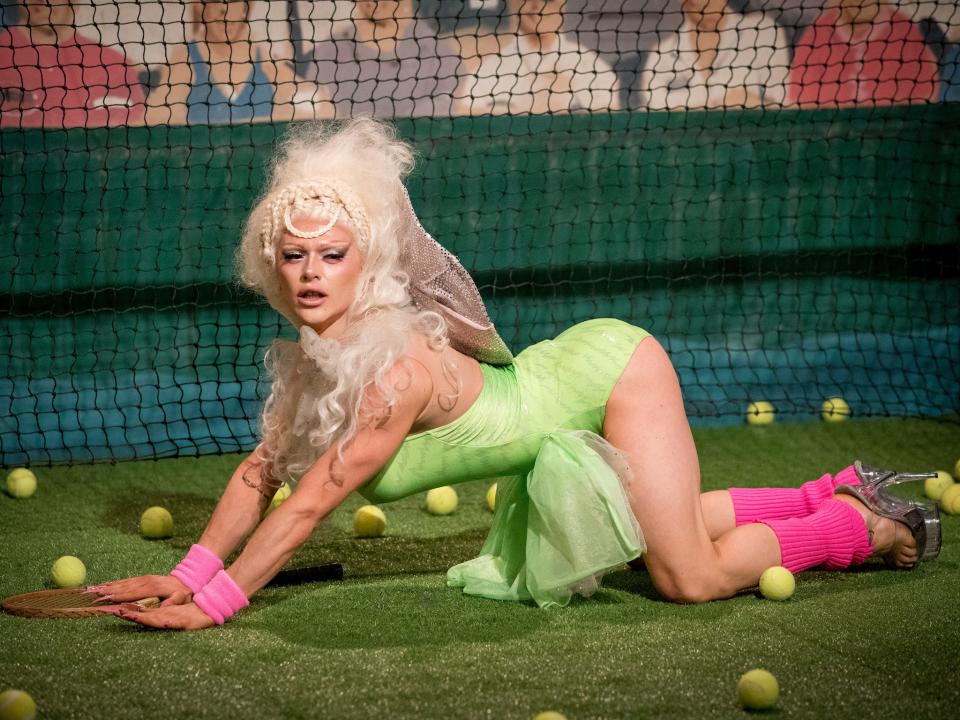RuPaul’s Drag Race UK review: Still innocent and chaotic enough to parody its polished American cousin

Where can you find Liz Hurley and a drag queen from East London catwalking with a box of Chicken Cottage? The premiere of Drag Race UK series two, of course.
The second series of the BBC’s take on RuPaul’s Drag Race – the US show that catapulted drag into the mainstream – is a reminder of why its first series worked so well. Once again, the eccentricity of British drag and the vulgarity of British humour form a “special relationship” with its US-imported format. This time around, there’s a diverse cast of contestants from across the UK, including Scotland and Wales (nations that weren’t represented in series one).
New faces, names, accents and wigs sashay across the screen, introducing us to local drag scene tensions – such as the supposed difference between a “Clapham queen” and an “East London queen”. As the search for the UK’s next drag superstar begins, so too does the familiar face-off between “new drag” and “old drag”, “comedy queens” and “look queens”, and everything in between. It’s enough to make people who feel mortified by Brexit and exhausted by the constant culture war over British identity feel a glimmer of patriotism.
Drag Race UK has returned at the perfect time. Before the pandemic, fans expressed fatigue at the regularity of new US seasons (plus “All Star” seasons, where former contestants battle it out against each other).
But now everything has changed. LGBTQ+ people have spent most of the last year separated from their chosen queer families, with the doors of venues where they’d normally watch drag shows firmly closed for business. In this new world, RuPaul’s presence and the oversaturated, artificial workroom feel familiar in the best possible way.

In each episode of Drag Race, the queens are given a brief by RuPaul, whether it’s a look to master, a group performance or a comedy routine. The queen who fails to impress Ru and judges Michelle Visage, Graham Norton and Alan Carr is given her marching orders and told to “sashay away” (though not before lip-syncing for her life, of course).
The format might not be revolutionary, but what makes the show so special, beyond the stunning costumes, razor-sharp one-liners and filthy innuendos, is the contestants. As we watch the queens attempting to nail RuPaul’s first brief – a look inspired by a UK gay icon, followed by another get-up inspired by their “hometown queen” – we’re reminded of the UK’s rich queer history and the decades of struggle, defiance and creativity that brought us to the point where a drag competition is a jewel in the BBC’s crown.
It’s difficult to separate Drag Race UK from its place in both the global Drag Race franchise and the reality TV life cycle. Most successful reality shows have a golden era – a few seasons where contestants are more naive to the fame that awaits them. In its prime, Drag Race US became popular by doing what drag does best: parodying and exaggerating its surroundings, like the hyper-serious competition shows such as America’s Next Top Model that preceded it.
Unlike the first series of Drag Race UK (which fans half expected to be a disaster), there is expectation on this year’s queens, who seem more conscious of the platform and aware that their every word can be turned into a reaction meme or gif. But as the original US show airs its 13th season – with A-list guest judges and pristine, Insta-famous contestants who are prepared for international stardom – Drag Race UK is, for now, still innocent and chaotic enough to parody its polished American cousin. (A parody of a parody – what could be queerer than that?)
Drag Race UK reminds us how different, funny and interesting people can be. To watch from the homes we’ve been confined to all year, in the loungewear that’s become the new normal, is to remember that life is colourful and noisy – to be enjoyed, not just endured. In a difficult time for all of us, that feels like something to celebrate.
Read More

 Yahoo Finance
Yahoo Finance 